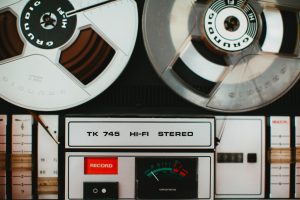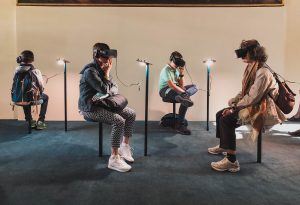With a sudden craving for fried chicken, my family took a spontaneous trip to KFC. Returning home with the rich, flavorful scent spreading across our dining room, I began to set the table. As I placed the signature KFC corn slaw off to the side, my brain clicked and I abruptly felt a puzzling sense of eerie familiarity. This exact scenario had happened before: the striped box with Colonel Sander’s face placed to the right, my chair diagonally pushed back, and the take-out boxes placed in a disorganized fashion. This exact moment had to have happened before…unless?
We hadn’t ordered take-out chicken in several months, so what was it? Was I born with exceptional photographic memory? Or did I somehow teleport and revisit the past? The answer to both is “no”, without a doubt. Okay, then what?
My friends and I have shared earnest conversations about this peculiar sensation called déjà vu which causes one to feel like they have experienced an identical situation before. In certain cases, the sensation occurs even while completing an activity for the first time. As déjà vu continues to reappear in my everyday life, I can’t help but wonder what really happens in our brains during this phenomenon. At last, I have decided to delve into the nitty gritty truths, or so I should say scientific theories, behind how déjà vu occurs.
There are a variety of scientific theories that attempt to accurately explain the internal processes of our mind and body during déjà vu. While déjà vu is medically considered a phenomenon experienced before temporal lobe epileptic seizures, it is also experienced by many people in their ordinary lives. Certain theories that have been repeatedly supported by researchers focus on mechanisms of dual processing, neurological interactions, memory, and split attention.
One such popular theory on déjà vu refers to the disruption of cognitive memory operations in the dual process theory, in which information is stored and retrieved through two different processes in the brain. To begin, one example of a dual process system includes the recollection and familiarity functions of retrieval. The recollection function refers to sending retrieval cues that prompt our brain to access information from a past memory. For example, taking exams like the SAT involves sending cues to our brain to retrieve information. This function is based on a threshold process where only surpassing a certain threshold of “recollective strength” allows information to be retrieved. Thus, not all previous events are able to be retrieved. The familiarity function, which determines how familiar an experience feels, depends on a signal detection process where previously studied or reviewed subjects are connected with greater familiarity than subjects that have not been reviewed. Although memory recollection and familiarity functions are usually active at the same time, there are instances when only one is active. When the signal detection process of only the familiarity function is active, a situation or setting may feel familiar, but the individual is unable to grasp which prior event this familiarity stems from since the recollection function remains inactive.
Another dual process involves memory encoding and retrieval functions. Encoding is the process of transforming sensory observations from an experience into memories that are connected with related subjects already stored in our brain. Andre de Nayer, EXPERT at KCE at the Government Ministry of Health in Belgium, hypothesizes that when the two separate channels of encoding and retrieving memories “meet in the same area”, these functions may occur simultaneously. This can lead to a present situation, which is being encoded, seeming like it has been recollected from a past memory through the retrieval function, even when it evidently has not. He illustrates this theory as a tape recorder having both its record and play button on. While there is great space for further neurological research, this remains a logical model of déjà vu in relation to the dual process theory.

Additionally, people have two types of consciousness, the normal variant and the parasitic variant. The normal consciousness is observant of the setting and events that occur outside, around the person. On the other hand, the parasitic consciousness focuses on one’s internal activities within the brain. In high levels of stress, the outer variant is unable to process sensory information correctly and the inner variant takes the dominant role to collect information through mental images. Such an event where the inner variant is dominant causes the individual to deem current experiences as old memories and feel an odd sense of familiarity. This theory is suggested by John Hughlings Jackson, an English neurologist with specific research emphasis on epilepsy. He recorded several accounts of experiencing these two variants alternating in dominant roles of observation, and as a result supports his explanation.
Another key theoretical perspective of déjà vu is focused on irregular neurological interactions. In the neurological interaction based theory, information is thought to pass through primary and secondary perceptual pathways toward the higher order cortical regions of the brain. While the primary pathway is a route for information to travel directly to the dominant hemisphere, the secondary pathway is discussed to be a route for information to travel to the nondominant hemisphere and then eventually to the dominant hemisphere. The dominant hemisphere manages rational, logical thinking and language skills while the nondominant hemisphere is in charge of creativity and spatial awareness. Information passing through the primary and secondary pathways are closely arranged in arrival time for the cortical regions to ultimately process the details as one event. As a result, the information delivered through these cognitive pathways must travel with precise timing. According to Robert Efron, a neurophysiology researcher, when information that travels through the secondary perceptual pathway passes an area of injury within the brain, there may be an abnormal delay in processing the information. This increased gap in arrival time may cause the brain to store the information as two independent events. Consequently, one event may seem as though it has occurred twice: once now and once before.
Next up, let’s take a look at memory storage theories. First off, the hologram theory suggests that memories can be stored as a pattern of neural activations throughout the brain, rather than one form of memory storage. This means a single factor of an environment that shares similarities with one of the neural activations can make the entire pattern of neural activations spark, causing the setting to feel familiar. Say you visit a Friendsgiving dinner (post quarantine, of course) and experience déjà vu while playing Slap Jack on a large living room rug. Truth is, you’ve never been in the same setting. Instead, you’ve sat on an extremely similar rug before and simply cannot identify where exactly that was. You create a holographic connection between only the rug from the past and the rug from the present. This triggers the pattern of neural activations from your previous memory, making you feel a strange sensation of familiarity.
While the biological reasons behind this theory are not concrete yet, we can also explore the renowned Gestalt familiarity model to gain insight on how the familiarity of certain aspects of the setting yield déjà vu moments. The Gestalt familiarity model states that a similar configuration of objects can result in the déjà vu phenomenon, even when the objects themselves are different. In 2012, an intriguing research study was conducted with virtual reality technology. 24 participants were introduced to 16 scenes to observe for 10 seconds each, including bedrooms, bowling alleys, junkyards and more. Following this step, each participant viewed 32 new scenes. Half of the scenes contained the same configuration of objects, though the objects themselves were not identical to the previously reviewed scenes. The other half did not carry the same configuration of objects as the reviewed scenes. Results showed participants expressing higher levels of familiarity and déjà vu experiences with scenes that resembled the same configuration of objects as the previously reviewed scenes. The study explained that the configuration of objects leads to déjà vu because the spatial similarities create a sense of familiarity without an explicit recall to specific memories. Altogether, the research investigation proved the validity of similar organizational patterns leading to increased accounts of déjà vu. Thus, the Gestalt familiarity model serves as a crucial and plausible explanation for the phenomenon today.

The fourth and last category of déjà vu theories we’ll explore is split attention. This explanation refers to a situation in which you focus on one object of the setting while continuing to unconsciously observe and record data of the overall setting. Our brain can unconsciously complete this because the observations are made by the subliminal self, the “self” existing below conscious awareness. While our supraliminal self, the “self” existing within conscious awareness, is “distracted by conscious evaluation of the incoming information” from the setting, the subliminal self is “like a continuous video camera recording moment to moment”. This occurs because our supraliminal self utilizes signals above the “absolute threshold level of our conscious awareness” while the subliminal self has signals below this threshold which allows for unconscious observations to occur. Once you stop focusing on one specific component, snap back to reality, and now observe the setting with full attention, you gain a sense of familiarity because you had already been collecting information unconsciously. In other words, when the supraliminal self realizes the information collected by the subliminal self, déjà vu is experienced.
Together, we have delved into the cognitive and biological aspects of déjà vu by reviewing the dual sense theory, neurological interactions, memory theories, and the split attention hypothesis. Note, theories are explanations based on previous scientific research, yet there is still much to discover about this strange phenomenon. Nonetheless, the progress our science community has made to understand this mysterious sensation is quite remarkable. After all, we’re no superheroes. We can’t see the future before every déjà vu moment nor do we have flawless photographic memory. Regardless, I’m continuously fascinated by our cognitive capacity to function in such intricate ways. You bet that the next time my family orders take-out, I’ll shout “DÉJÀ VU!” for the pure chance to share about our discoveries.
Sources:
Cover Illustration by Diana Presas
- https://ajp.psychiatryonline.org/doi/abs/10.1176/ajp.147.12.1587
- https://courses.lumenlearning.com/wmopen-psychology/chapter/how-memory-functions/
- https://doi.org/10.1111/j.0963-7214.2004.00320.x
- https://doi.org/10.1093/brain/11.2.179
- https://doi.org/10.1093/brain/86.3.403
- https://doi.org/10.1016/j.concog.2011.12.010
- https://www.ncbi.nlm.nih.gov/pmc/articles/PMC4251874/
- https://pubmed.ncbi.nlm.nih.gov/515449/
- https://pubmed.ncbi.nlm.nih.gov/12784936/
- https://www.verywellmind.com/memory-retrieval-2795007
- https://visme.co/blog/subliminal-messages/#:~:text=Subliminal%20messages%20are%20defined%20as,ATL
Images:
- https://unsplash.com/photos/gnhxvdGmGG8
- https://unsplash.com/photos/IMUwe-p1yqs
